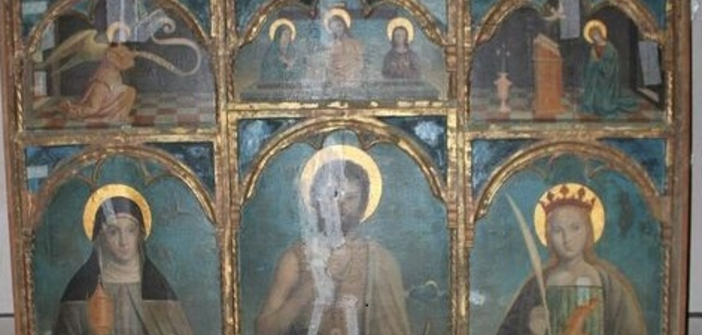The Alpes-Maritimes Department and the State funded part of the works.
The fundraising appeal launched by the Heritage Foundation collected almost 15% of the budget, with active participation from students mobilized by the Safeguarding of French Art.
This altarpiece is composed of seven compartments. The panels are simply framed with carved wood; Saint John the Baptist is featured at the center, surrounded by Saints Claire of Assisi and Catherine of Alexandria.
A bit of history of the Niçoise “primitives”
Many paintings from the 15th and 16th centuries await visitors in numerous religious buildings: convents and monasteries, churches and chapels, as well as in the villages of the Niçoise hinterland and in Liguria.
During this period, several itinerant painters from Nice or elsewhere traveled across the Niçoise region to create altarpieces or frescoes.
Starting from 1450, the Niçoise region will experience a true golden century, with the years 1475 to 1520 marking the peak with the emergence of the “Niçoise primitive painters.” This period falls between the end of Gothic and the beginning of the Renaissance. Among these painters, the Brea family stands out, residing in old Nice.
The most famous among them, Louis, left numerous works in Provence (Aix, Marseille, Les Arcs), in Liguria (Taggia, Genoa), and in the County of Nice, among the most celebrated works are the Virgin of the Rosary of Biot, the Pieta, and the Crucifixion at the Cimiez monastery (the Crucifixion was recently restored and is currently exhibited at the Masséna Museum in Nice).
His brother Antoine was also a very active painter in the County of Nice and Liguria, as evidenced by the altarpiece of Saint Anthony of Genoa (Palazzo Bianco), the Deposition of the Cross at the Cimiez monastery, and the altarpiece of Saint John the Baptist at Bonson. His art is heavily influenced by his brother’s work.
Finally, François, Louis’ nephew, was influenced by Piedmontese painters. He also worked in the County of Nice and in Liguria. Among his works are the Virgin of Mercy of Saint Martin d’Entraunes, and the Virgin in Majesty between Saint John the Baptist and Saint Sebastian at the St. Bartholomew church in Nice.


